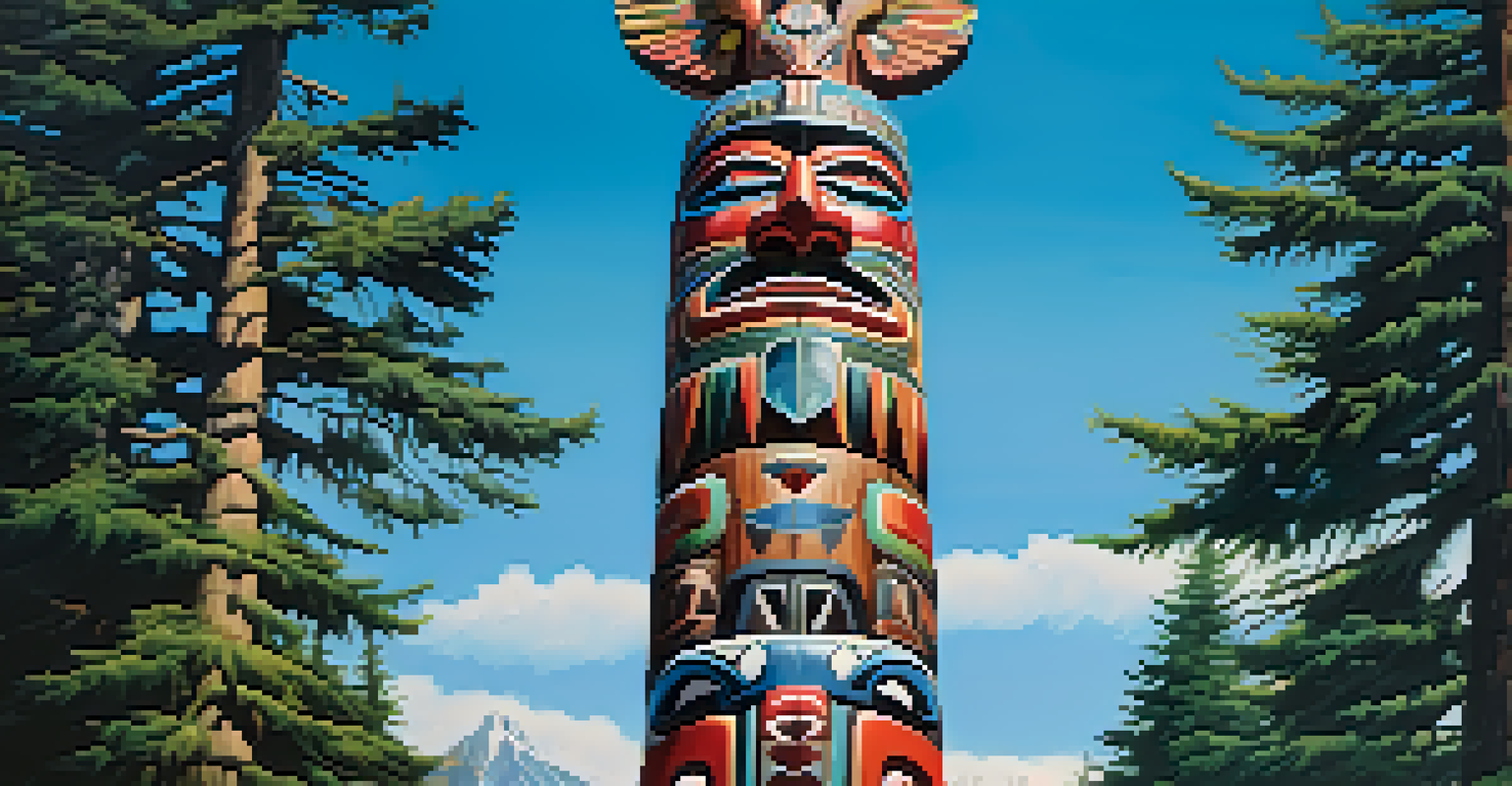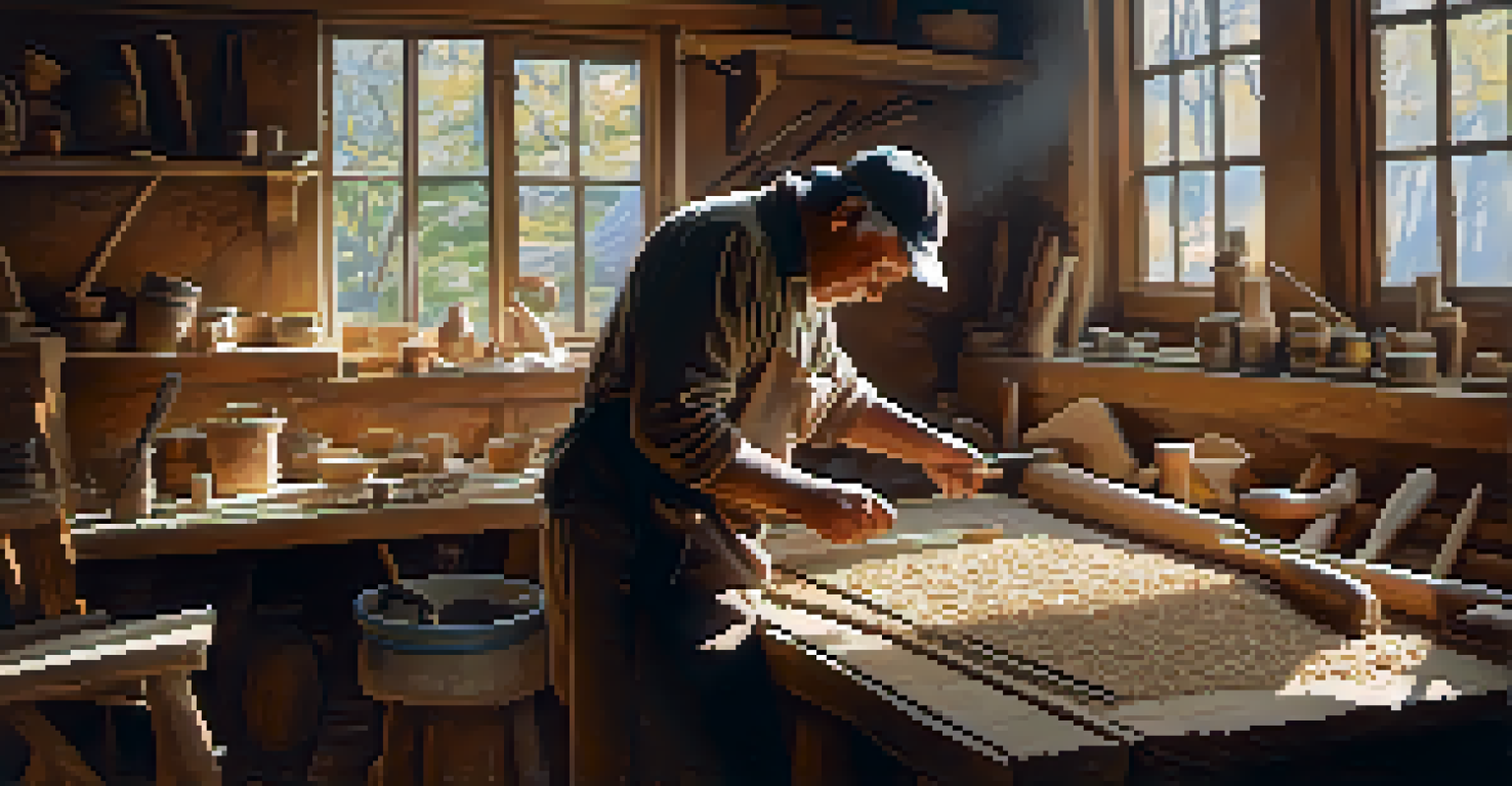The Influence of Indigenous Carving on Global Art Forms

Understanding Indigenous Carving: A Cultural Backbone
Indigenous carving is more than just an art form; it's a rich cultural expression that tells the stories of communities. From the intricate designs of Maori carvings in New Zealand to the vivid totem poles of the Pacific Northwest, these creations reflect the identity, beliefs, and history of Indigenous peoples. Each piece is imbued with meaning, often representing ancestral connections or spiritual narratives.
Art is a way of survival. It's a method of thriving, a way of creating community and a way of connecting to the past.
The materials used in Indigenous carving—wood, bone, stone, and more—vary by region but often hold significant cultural value. For instance, the use of cedar in the Pacific Northwest is not only practical but also symbolic, representing the lifeblood of coastal Indigenous cultures. Through these mediums, artisans skillfully create works that resonate with their heritage and the natural world.
As we delve into the world of Indigenous carving, it becomes clear that these artistic practices serve as a bridge, connecting generations and preserving traditions. They invite us to appreciate the depth of cultural narratives woven into each piece, prompting a greater understanding of Indigenous worldviews and their relationship with nature.
The Techniques Behind Indigenous Carving Masterpieces
Indigenous carving techniques are often passed down through generations, showcasing a blend of skill, tradition, and innovation. Techniques may include hand carving, whittling, and even modern methods that incorporate technology while respecting traditional values. This fusion of old and new allows artisans to create stunning pieces that resonate with contemporary audiences.

For example, the intricate detailing found in traditional Maori carving involves not only artistic talent but also deep knowledge of symbolism and storytelling. Each curve and pattern has specific meanings, often tied to genealogy or significant events. This attention to detail elevates the work, transforming it from mere decoration to a powerful narrative medium.
Cultural Significance of Carving
Indigenous carving serves as a vital cultural expression that preserves the identity, beliefs, and histories of communities.
The craftsmanship involved in Indigenous carving also reflects a profound respect for the materials used. Carvers often choose their materials carefully, considering the spiritual and cultural significance of each choice. This connection to the earth and its resources emphasizes sustainability, a principle that resonates with global artistic movements today.
How Indigenous Carving Influences Contemporary Art
The influence of Indigenous carving can be seen across various contemporary art forms, from sculpture to fashion and beyond. Many modern artists draw inspiration from traditional motifs and techniques, blending them with their unique styles to create innovative works. This cross-pollination enriches the global art scene, fostering a dialogue between past and present.
Indigenous art and culture are the most powerful forms of resistance, through which we reclaim our stories and identities.
One prominent example is the use of Indigenous designs in contemporary fashion, where designers incorporate traditional patterns into their collections. This practice not only celebrates Indigenous artistry but also raises awareness about cultural appropriation, prompting discussions on respect and ownership in the art world. Through these collaborations, Indigenous voices gain visibility in mainstream culture.
Moreover, exhibitions showcasing Indigenous carving at prominent galleries and museums highlight its significance within the broader spectrum of art history. By placing these works in global contexts, audiences are invited to engage with Indigenous perspectives and appreciate the depth of their contributions to contemporary art.
The Role of Indigenous Carving in Cultural Identity
Indigenous carving plays a crucial role in shaping and preserving cultural identity. For many communities, these artistic practices are a form of resistance against colonial narratives and a means to reclaim their heritage. Carving becomes a powerful tool for storytelling, allowing Indigenous artists to share their histories and philosophies with the world.
Through their work, carvers express their connection to the land and their ancestors, reinforcing the values and beliefs that define their communities. This act of creation is not just about aesthetics; it's a profound statement of existence and resilience. As such, Indigenous carving becomes a medium for cultural revitalization, inspiring younger generations to embrace their roots.
Techniques Passed Through Generations
Carving techniques are often handed down through generations, blending traditional skills with modern innovations to create meaningful art.
In a globalized world, where cultural homogenization is prevalent, Indigenous carving stands as a testament to the strength of diversity. It encourages all of us to explore and celebrate different narratives, fostering a deeper understanding of the rich tapestry of human experience.
Global Collaboration: Indigenous Carving and Art Communities
In today's interconnected world, Indigenous carvers often collaborate with artists from various backgrounds, creating unique pieces that reflect a blend of cultures. These partnerships can lead to innovative works that honor traditional practices while exploring new themes and techniques. Collaborative projects also foster mutual respect and understanding between diverse artistic communities.
For instance, workshops that bring together Indigenous carvers and contemporary artists allow for knowledge exchange and skill sharing. This interaction not only enhances artistic practices but also builds bridges between communities, promoting cultural appreciation and awareness. Through these collaborations, the essence of Indigenous carving can reach broader audiences, creating a lasting impact.
Such global partnerships also highlight the importance of supporting Indigenous artists in the contemporary art market. By recognizing and valuing their contributions, we can help ensure that Indigenous carving continues to thrive, adapting to new contexts while remaining rooted in tradition.
Preserving Indigenous Carving Traditions for Future Generations
As Indigenous carving faces challenges from modernization and globalization, efforts are underway to preserve these vital traditions. Initiatives that promote cultural education, workshops, and mentorship programs are essential in ensuring that younger generations learn the art of carving. By fostering skills and knowledge, these programs keep the traditions alive and relevant.
Museums and cultural institutions play a significant role in this preservation, providing platforms for Indigenous artists to showcase their work. They also offer educational resources and programs that teach the significance of carving within Indigenous cultures, helping to raise awareness among wider audiences. This visibility is crucial in countering stereotypes and promoting understanding.
Global Collaboration in Art
Collaborations between Indigenous and contemporary artists foster mutual respect, innovation, and broader visibility for Indigenous carving.
Furthermore, community-driven projects that focus on collaborative carving can strengthen cultural ties and inspire pride in heritage. By engaging local youth in these initiatives, we not only pass on skills but also instill a sense of belonging and responsibility towards their cultural legacy.
The Future of Indigenous Carving in a Globalized World
Looking ahead, the future of Indigenous carving appears promising yet complex. As the world embraces diversity, there is a growing appreciation for Indigenous art forms, leading to increased demand and visibility. However, this trend also comes with challenges, such as the risk of cultural appropriation and the need for ethical engagement with Indigenous communities.
To navigate these complexities, it's vital to prioritize dialogue and collaboration with Indigenous artists. By respecting their voices and ensuring they are at the forefront of discussions regarding their art, we can create a more equitable art landscape. This approach fosters genuine connections that celebrate the richness of Indigenous culture without exploiting it.

Ultimately, the future of Indigenous carving lies in its ability to adapt while remaining rooted in tradition. By continuing to create, collaborate, and educate, Indigenous artists can ensure that their legacies thrive, enriching the global art scene for generations to come.